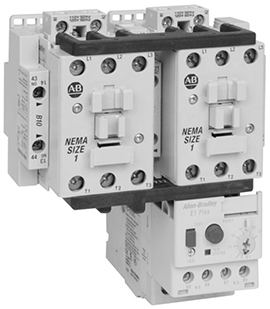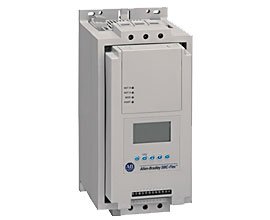
3 Options for Starting and Stopping an AC Motor
Ron Daggett | 17 March 2014
Often in an industrial environment, terms get thrown around that may leave you wondering a bit. This article is an attempt to explain the different ways of starting and stopping AC motors. These motors can be used for anything from running a conveyor to raising a gantry arm. This article will address the three means to control the motors from lowest to highest capability and cost.
Motor Starter
A motor starter is nothing more than a contactor in series with an overload. The contactor is an electromagnetic switch that can handle a lot of current. The overload is an automatic means of killing power to the AC motor if there is too much current (current overload) or if the wires heat up too much (thermal overload).
Features
- Minimal flexibility
- Abrupt starts and stops
- Lowest priced option ($125-$150)
- Low heat dissipation in enclosure
- Takes minimal control panel space
Applications
- Motors that have a very low duty cycle
- Motors that can be abruptly started and stopped
Soft Start
 A soft start is one step up from a motor starter. A soft start gets its name because it gives you the ability to select a ramp up and ramp down time for starting and stopping your AC motor. For example, if you have an unstable load on a belt conveyor (think stacked up paint cans on a pallet), you don’t want to stop the conveyor belt “on a dime”.
A soft start is one step up from a motor starter. A soft start gets its name because it gives you the ability to select a ramp up and ramp down time for starting and stopping your AC motor. For example, if you have an unstable load on a belt conveyor (think stacked up paint cans on a pallet), you don’t want to stop the conveyor belt “on a dime”.
If you stopped the conveyor immediately, the momentum from the load on the pallet would cause the load to topple over. With a soft start, you can “program” an acceleration and deceleration for the load. In the example above you may want to take 2 or 3 seconds from full speed to zero to have a controlled stop. The acceleration and deceleration are typically controlled by dip switches or a potentiometer on the soft start.
Features
- Some flexibility
- Limited number of start/stop acceleration profiles
- Costs more than Motor Starters but less than VFDS ($300 - $350)
- Medium heat dissipation in enclosure
- Takes minimal panel space – same profile as motor starter
Applications
- Motors where you have to have a controlled start and stop
Variable Frequency Drive (VFD)
 A VFD gives the ultimate flexibility and capability in controlling an AC motor. A VFD is a device that is able to control not only the acceleration and deceleration, but also a multitude of other motor characteristics including:
A VFD gives the ultimate flexibility and capability in controlling an AC motor. A VFD is a device that is able to control not only the acceleration and deceleration, but also a multitude of other motor characteristics including:
- Speed
- Can generate multiple faults for better diagnostics
- Can generate torque at zero speed to hold a load
- Can accept analog inputs to control speed
- Can control braking for a motor
Features
- Maximum flexibility
- Unlimited number of start/stop acceleration profiles
- Cost is much more than Motor Starters but only a little bit more than Soft Starts ($400 - $1000 )
- Large heat dissipation in enclosure
- Takes more panel space - Field mount to minimize
Applications
- Any motor that you need fine control and flexibility
Hopefully, this explanation removes some of the mystery behind controlling AC motors. The most important thing is to make sure you get the right technology for the application. Once an AC motor is deployed in the field, it is expensive, painful, and difficult to switch to a different technology. If there is any doubt, spend the extra money up front. The relatively small amount of money will buy you flexibility in the field.
Comments
Irfan says:
8/28/2018 10:09 AM
Wowwww, very nice, to the point and some-up information.
Regards
Anthony B says:
8/28/2018 10:09 AM
Thank you, perfectly summarized
Leave a Reply
Your email address will not be published.
Comment
Thank you for your comment.